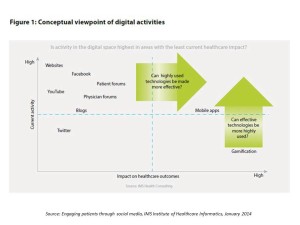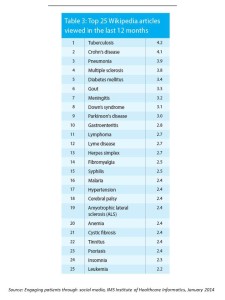Millions of health citizens, consumers, patients and caregivers flock to Facebook, Twitter and Wikipedia every day the world over to seek health information, advocate for patients’ access to a cancer therapy on a health blog, engage in peer-to-peer health care in a social network, and bolster each others’ management of chronic medical conditions in a chat community.
Yet the pharmaceutical and medical device industries rank well behind other industries vis-à-vis the use of social media, asserts Engaging patients through social media, with the punchline question: is healthcare ready for empowered and digitally demanding patients? from the IMS Institute for Healthcare Informatics, published on 21st January 2014.
The report discusses the chasm between people (those named above – health consumers, et. al.) and their use of social media for health, versus relatively low engagement with social media among pharma and med tech firms. Murray Aitken, Executive Director of the IMS Institute, explained in a webinar held earlier this month that about one-half of these companies are engaging in social, and half, he said, “are on the sidelines.” The #1 excuse, he asked and answered: “FDA regulation.”
But it’s mainstream behavior for consumers seeking health information socially; social media are “the place where patients gather to talk about their health,” Aitken explained. In that sense, social networks are an important part of the landscape for pharma manufacturers to understand and be part of, Aitken asserted.
IMS created a health social media index as a means to quantitatively assess the extent to which pharmas are engaging with patients. The index assesses reach, relevance and relationships in social media interactions, and employs a scoring and weighting mechanism enabling IMS to compare companies’ involvement with health consumers in social media.
Based on this methodology, the top-ranked company emerged as Johnson & Johnson with an index score of 70. The next highest social media engagement score of 25 was achieved by GlaxoSmithKline, followed by Novo Nordisk with 23, Pfizer with 20, and Novartis and Boehringer Ingelheim each scoring 18. Thus, J&J is way, way ahead of other organizations serving health consumers in pharma based on IMS’s index.
Aitken explained that J&J may be well ahead of the pack because of the importance of the company’s consumer health franchise. Still, he continued, other companies operate health businesses that are consumer-facing and should engage with patients where they aggregate (that is, in social networks).
IMS spent significant effort examining the role of Wikipedia in health, which is used by millions of patients and 50% of U.S. physicians – especially for information on specific conditions. IMS looked at 5,236 English language pages on Wikipedia, and found that pages featuring rarer diseases are more frequently visited than those of more common conditions. The table illustrates IMS’s top 25 findings, showing that TB, Crohn’s Disease, Pneumonia, MS, and Diabetes are the top 5 used Wikipedia pages in medicine.
The timing of IMS’s paper follows by a matter of days the FDA’s issuance of draft regulatory guidance clarifying the industry’s use of social media. While the industry may be waiting for final guidance from the FDA promised to be released in the summer of 2014, that guidance won’t provide black and white assurance to the industry, Aitken expects.
“There’s no part of the pharma industry that has perfect clarity,” Aitken said. Things are moving in the real world faster than in the regulatory world so “we shouldn’t be surprised if there are things we can’t imagine today that will be there in 12 to 24 months,” Aitken continued. These innovations won’t be directly referenced by final guidelines,” and we’ll be behind the ball once again. He described this as an “ongoing reality.”
What does this mean for industry? It will require taking a measured approach and a bit of risk, Aitken recommended. A little bit of trial and error is needed, done in a thoughtful and systematic way, he concluded.
Health Populi’s Hot Points: The answer to the report’s title question – “is healthcare ready for empowered and digitally demand patients?” – is absolutely not.
I serve on the HIMSS Connected Patient Committee, where a dedicated group of professionals active in health IT and social media has been working for several years to educate health providers and the larger ecosystem of payers and suppliers about the central role of people-patients in health. Our latest paper on Personal Health Information Technology is all about how consumers are adopting technology and tools (including but not limited to social networks and mobile platforms) to transform their own health care and care for people they love.
This is not new-news. I wrote The Wisdom of Patients: Health Care Meets Online Social Media nearly 5 years ago in April 2008 for the California HealthCare Foundation. Pharma is largely where it was back then with respect to social media – when Facebook and Twitter were nascent. But there were pioneering social health networks like DiabetesMine, Patients Like Me, Stupid Cancer (the I’m Too Young for This! Foundation), and WEGO Health.
I profiled all four of these patient social networks in the Wisdom paper, and guess what? They’re all still around, resilient, some 1,800 days later.
And pharma in social networks? Not a whole lot new there, except for J&J’s continued commitment to getting closer to patients.
As health care in America goes increasingly consumer-directed and value-based, organizations that lag behind and can’t prove their economic or social value will further lag. The brand equity calculus today requires social engagement. As consumers are asked to pay more out-of-pocket for care and health products, they/we will want health industry stakeholders (read: marketers) to show up in social media, which now, for people and patients, isn’t really social media anymore.
It’s just How and Where We Live.






 Thank you FeedSpot for
Thank you FeedSpot for